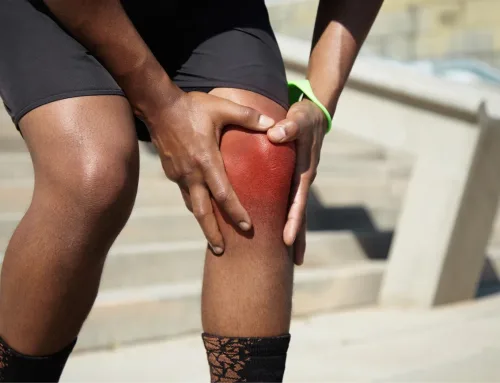Table of Contents
Ankle sprains are very common, especially in athletics or other sports related activities. The ankle joint is found to be involved in ⅓ of sports related injuries with up to 83% of these injuries being related to ankle sprains.
When an ankle is sprained, there is an excessive and quick force to the ligaments that provide the ankle with stability and support. The ligaments are typically the main part of the ankle to be injured in ankle sprains. But with increasing amounts of force, tendons, nerves, and bones can also be injured.
For now, we will focus on what happens to the ligaments during an ankle sprain.
Ligaments
Ligaments connect bone to bone and are very strong bands of connective tissue. Ligaments also have receptors within the layers of connective tissue that help to provide your body with information on where your foot is in space, helping with balance and coordination.
There are several ligaments of the ankle, both on the inside or medial portion, and the outside or lateral portion. Lateral ankle sprains are the most common with the anterior talo-fibular ligaments (ATFL) being most involved.
Lateral ankle sprains occur when the foot and ankle become twisted into inversion and plantar flexion, also known as rotating the foot in and down. Think of stepping off of a curb and landing on the outside of your foot. Since lateral ankle sprains are so common, you can probably think back to a time when you sustained a lateral ankle sprain, even if it was very mild.
Other structures
The outside, or lateral portion of the ankle is also made of up tendons from your peroneus longus and brevis, which are muscles that help to stabilize the ankle and to turn your foot out. There are nerves that run along the outside of your ankle that help to provide sensation to your foot. And there bones that can actually be fractured during a very bad lateral ankle sprain. The most common type of fracture during an ankle sprain is an avulsion fracture, or when a part of the bone is pulled off due to an excessive amount of pulling force from a tendon and muscle.
Grades of ankle sprains
Ankle sprains can clearly present as simply having mild pain to not even being able to put weight through your foot. Doctors and other medical professionals use a grading scale to determine how bad the sprain is and how to best treat the sprain.
Grade I
- No loss of function
- No laxity of the involved ligaments
- Minimal bruising and swelling
- Minimal stiffness
Grade II
- Some loss of function
- Mild laxity of the involved ligaments
- Some bruising and swelling
- Some stiffness
Grade III
- Near total loss of function
- Significant laxity of the involved ligaments
- Bruising, specific tenderness, and visible swelling
- Significant stiffness
- May not be able to walk well
- If fracture is involved then unable to walk at all on involved leg
No matter what grade the ankle sprain is, treatment should begin with ice. Ice should be used throughout the beginning stages of recovery to reduce pain, swelling, and to improve ability to stand and walk on that ankle.
Besides ice, rest, and elevation, protective measures should be taken. Use of external support devices such as a brace and crutches should be used to protect the ankle and ligament involved. These will also allow you to stand on and walk on the ankle within tolerable amounts of pain and range of motion. Overtime, as the ankle sprain heals, you will begin to notice how you can put more and more weight on the foot and ankle, until you get to the point where you can discontinue use of the external support devices.
In grade I injuries, you may not even need much support for very long. In grade III injuries you may need prolonged immobilization. And if a fracture is involved you may need to be casted.
For the best results and fastest recovery, treatment should also consist of lymphatic drainage to help decrease bruising and swelling. Passive range of motion from a Physical Therapist and tolerable active movements from yourself also promote decreased swelling and pain while promoting healing and a safe return to functional activities.
Gentle, well tolerated movement is one of the best things you can do for an ankle sprain, as long as there are no contraindications, such as an avulsion fracture. Plus addressing the mobility impairments will help you return to normal walking and use of the foot and ankle more quickly.
Appropriately graded exercises should also be performed. This should start with easy, gentle, low intensity exercises and progress to more strength building exercises as pain decreases and function increases. Exercise won’t only help the ankle to feel better but it can decrease the risk of another ankle sprain happening again.
Balance training is another component of the rehabilitation after an ankle sprain. Those receptors previously mentioned in this article, the ones that help to know where the ankle is in space, can be over stretched and damaged in an ankle sprain. Balance exercises help to rehabilitate, not just balance and coordination, but the ability of those receptors to work and to allow the ankle to fine tune its movements and positioning.
Re-injury
The rate of re-ocurring lateral ankle sprains is actually quite high. It has been reported that ⅓ of the patients that sustain a lateral ankle sprain will re-sprain their ankle at some point. This can be a result of returning to activity too quickly or from not fully rehabilitating the ankle, ensuring the mobility, strength, power, and balance are all ready to resume normal level of activities.
Re-injury can occur not just right after a return to activity, but even years down the road. It is very important to not only make sure you receive medical treatment after your first ankle sprain, but to also follow through with the whole plan of care for rehabilitation, to help minimize your risk of another ankle sprain.
Sometimes an ankle brace may be worn when returning to high level activity to help decrease risk of another ankle sprain. However, you should not become reliant on a brace as your ankle and foot should be strong enough to handle the activity on its own.
If you have suffered an acute ankle sprain, or perhaps you have had one in the past, it is wise to reach out to your doctor for an assessment to ensure that you can take care of the acute injury or any lingering symptoms or impairments from a previous injury.






